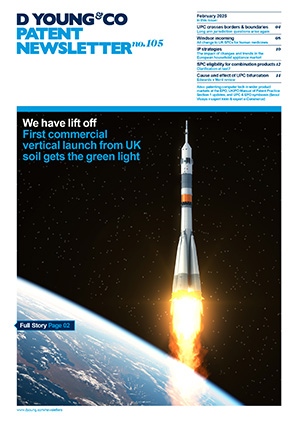Newron can't play fast and loose: UK Patents Court restricts combination SPCs
In a recent decision, the UK Patents Court considered the issue of whether supplementary protection certificates (SPCs) could be granted for a product which is a combination of two active ingredients (A+B), based on a basic patent claiming the combination A+B, and a marketing authorisation for only one of those active ingredients (A), when issued together with instructions in the summary of product characteristics (SmPC) that the product A should be taken in combination with B. Such a combination has been termed in the art as a “loose” combination of A and B. The court held that such a marketing authorisation and SmPC could not support an SPC for A+B, affirming the UK Intellectual Property Office’s (UKIPO’s) decision that the use of the product cannot be taken into account when determining the product for which SPC protection is sought, and confirming that the loose combination SPC did not meet the requirements of Article 3(b) of Regulation (EC) 469/2009 (the SPC Regulation).
Newron Pharmaceuticals Spa owned a basic patent (EP1613296B) claiming the use of safinamide, in combination with levodopa, and a peripheral decarboxylase inhibitor (PDI) for the treatment of Parkinson’s disease. It obtained a marketing authorisation from the European Medicines Agency (EMA) for safinamide, but with wording in the SmPC that the drug is indicated as add-on therapy to levodopa and other PDI medicinal products in the treatment of Parkinson’s disease.
SPC application
Newron then sought a UK SPC based on the above basic patent and marketing authorisation, arguing before the UKIPO that the reference in the SmPC, that the active ingredient safinamide was indicated as add-on therapy, meant that the authorised product was a combination product. The UKIPO hearing officer disagreed, being of the view that the marketing authorisation was for safinamide alone, and that the wording in the SmPC related solely to the intended use of the product and did not change the fact that the marketing authorisation granted was for safinamide alone. On this basis, and existing UK and Court of Justice of the European Union (CJEU) case law on SPCs, the UKIPO decided to refuse the SPC application on the grounds that Article 3(b) of the SPC Regulation was not met.
Appeal
Newron appealed that decision to the UK Patents Court, arguing that the term “product” may have a different meaning between the various limbs of the SPC Regulation, and that the wording in the SmPC meant that the authorised product was in fact a combination product.
The court dismissed Newron’s appeal, confirming that the instructions in the SmPC to take safinamide as an add-on to levodopa did not mean that the definition of the authorised product changed from safinamide alone to safinamide in combination with any other actives. The UKIPO’s decision that the SPC did not meet Article 3(b) of the SPC Regulation was therefore upheld.
In this regard, the court cited the CJEU decisions in Pharmacia Italia (C-31/03), MIT (C-431/04), Yissum (C-202/05), Abraxis (C-443/17) and Santen (C-673/18), as well as its own decision in Yeda v Comptroller-General of Patents [2010] EWHC 1833. In all of these cases, the court ruled that Article 1(b) of the SPC regulation requires that that the “product” is strictly confined to the active ingredient which is the subject of the marketing authorisation.
The court confirmed that this case law meant that neither the intended use of the product, nor the presence of other excipients in the formulation, change this definition, regardless of the merits of the invention on which the basic patent relied.
Newron therefore confirms existing UK and CJEU case law on SPCs, that the definition of the “product” for SPC protection is strictly limited to the active ingredient of the authorised medicinal product, and that the intended use of the product cannot be taken into account when determining the definition of the product. Significantly, the court’s decision explicitly extends this principle to the effect that instructions in the SmPC, that the approved product (A) should be taken in combination with another product (B), cannot change the definition of the product as set out in Article 1(b), from a mono-product A into a combination product A+B.
Key takeaways
This decision significantly limits the possibilities for obtaining combination SPCs in the UK, effectively closing the door to such combination SPCs based on loose combination marketing authorisations. Following this decision, only an marketing authorisation to a fixed combination including both A and B in the same pharmaceutical preparation would be sufficient to support a UK SPC to the combination A+B in the future.
Applicants seeking SPC protection for combination products in the future will need to re-think not just their SPC strategy but also the underlying regulatory strategy, perhaps seeking approval for a fixed combination rather than a loose combination. We would be pleased to assist with SPC strategy on products that have obtained or are expected to obtain an marketing authorisation. If this would be of interest, please contact us.
Case details at a glance
Jurisdiction: England & Wales
Decision level: High Court
Applicant: Newron Pharmaceuticals Spa
Citation: [2023] EWHC 1471 (Ch)
Date: 26 May 2023

